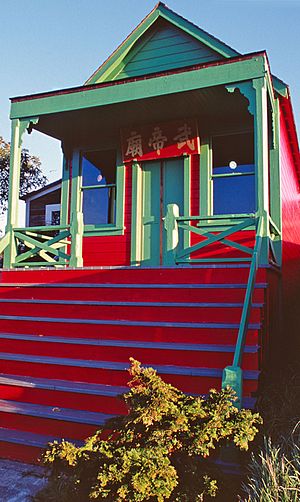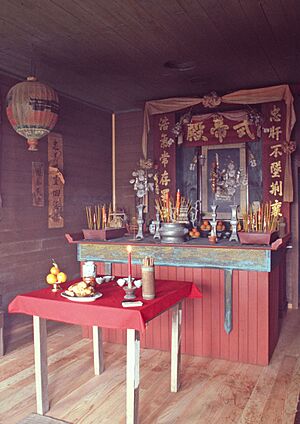Temple of Kwan Tai facts for kids
Quick facts for kids Temple of Kwan Tai武帝廟 |
|
|---|---|

Temple of Kwan Tai exterior
|
|
| Religion | |
| Affiliation | Chinese Taoist |
| Location | |
| Location | Mendocino, California, USA |
| Materials | Coast Redwood |
| Reference no. | 927 |

The Temple of Kwan Tai (Chinese: 武帝廟; pinyin: Wǔdì miào), also known as the Mendocino Joss House, is a special Chinese Taoist temple. It is located in Mendocino, California, USA. This temple is dedicated to a famous Chinese general named Kwan Tai. It is recognized as California Historical Landmark #927.
The temple was built in the mid-1800s using local redwood trees. It served many Chinese immigrants who came to work in the lumber industry in Mendocino. Some of these immigrants were survivors from Chinese ships called junks. These ships had sailed to California hoping to find gold but ended up on the Mendocino coast instead.
For many years, the temple was passed down through Chinese families. In 1995, a group was formed to help fix up and take care of the temple. Today, it is still used for worship. It also teaches visitors about the history of Chinese Americans. It is one of the oldest Chinese temples in California that has been used continuously. It is also the only remaining Chinese temple, or "joss house," on the northern California coast.
Contents
What the Temple Looks Like
The Temple of Kwan Tai is a small building painted in bright red and green colors. It is made from redwood wood. The temple has two doors, three windows, and a gable roof (a roof that slopes down on two sides). It is located at 45160 Albion Street in Mendocino. It faces south, looking out towards the Pacific Ocean.
Nine steps lead up from the street to the front door. People say this number helps keep away bad spirits. The temple's name is written above the door in Chinese characters. These characters mean "Military God-king Temple." The main room of the temple is about 264 square feet. There is also a small room at the back. This room used to be where the temple keeper lived, but now it is used as an office.
The temple honors a deified general from the Han Dynasty named Kwan Tai. Inside, the main altar has a picture of Kwan Tai. He is shown with two other generals, Liu Bei and Zhang Fei. This picture is decorated with shells and glass on a black cloth. A table in front of the altar holds five special pewter decorations. Prayer signs and donation records hang on the walls. There are also flags, drums, and baskets near the altar. The room has two wooden benches and a furnace for burning offerings. Special Taoist mandalas (circular designs) hang in the two front windows.
Building the Temple and Its Early Days
Many Chinese workers came to Mendocino County to work in the lumber industry. This was similar to other settlers in the area. In 1854, a Chinese junk ship landed near Mendocino. It was one of two ships that survived from a group of seven that had sailed to California. One of the people on this ship, Joe Lee, helped build the temple. His family still takes care of it and worships there today.
Over the next few decades, Mendocino had a large Chinese population, around 500 to 700 people. They worked as cooks, servants, and shopkeepers. Many also worked in the lumber industry. Some were "water slingers," who kept trails wet so logs could slide easily. Chinese farmers also grew fruits and vegetables for people in the area. They also collected and processed seaweed to send back to China. Some of these immigrants' children, like Look Tin Eli, became very successful business owners.
One story from a Mendocino resident, George Hee, says the temple was built in 1854. However, other records suggest it might have been built in 1852 or 1867. The oldest official record of the temple is from an insurance map in 1883. The materials to build it first cost only $14. The temple was made bigger in the 1870s. At that time, it had a full-time priest. It was open all the time for the Chinese community.
Passing Down and Restoring the Temple
The temple's ownership was passed down through families. George Hee's grandfather passed it to his mother, Yip Lee. She then passed it to George Hee. Mendocino's Chinatown area burned down in 1910. Over the years, most Chinese people left the area until only George Hee remained. He later passed the temple property to his two daughters, Loretta Hee McCoard and Lorraine Hee-Chorley.
In 1995, his daughters gave the temple to a non-profit group called Temple of Kwan Tai, Inc. This group was created to help take care of the temple. The Temple of Kwan Tai is now the only remaining joss house (Chinese temple) on the northern California coast. It was named a California Historical Landmark #927 in 1979.
The temple began to be restored in 1998 and 1999. An architect named Laura Culberson led the work. Money for the restoration came from the National Trust for Historic Preservation and the California Coastal Resources Agency. The restoration work included:
- Replacing the building's foundations.
- Fixing the east wall and the floor.
- Adding insulation to keep it warm.
- Repainting the temple.
- Adding a special plaque to show it is a historic landmark.
- Replacing the original altar picture, which was damaged. A new one was bought in Chinatown, San Francisco.
The temple was celebrated again in October 2001. There was a special religious and cultural ceremony. It included a parade, a lion dance, and martial arts shows. Buddhist nuns and local politicians also attended. In 2002, the temple received a National Preservation Honor Award.
Temple Activities
The Temple of Kwan Tai is one of the oldest Chinese temples in California that has been used continuously since it was built. Other Chinese temples from the 1850s in California include the Weaverville Joss House, San Francisco's Tin How Temple, and the Bok Kai Temple in Marysville.
The temple is used for traditional Chinese rituals. During these rituals, a person kneels and bows at the altar. They place offerings on the table or burn them in the furnace. Food offerings are made on the first and 15th day of each month, and during the new moon. Incense is burned every day. People can also use the temple for divination (seeking guidance) using kau cim sticks and jiaobei blocks.
Besides being a place of worship, the temple also helps teach people about the history of Chinese contributions to California. It welcomes visitors from the Mendocino community and beyond.
Images for kids



